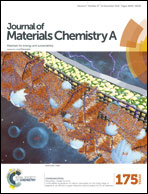Synergistic effect of fluorination and regio-regularity on the long-term thermal stability of polymer solar cells†
Abstract
Three structurally identical polymers, except for the number of fluorine substitutions, namely PF0, PF1 and PF2, are designed and synthesized, in order to investigate the impact of fluorination on the thermal stability of polymer solar cells. Devices based on the three polymers can retain ∼90% of their initial efficiency, after annealing for 30 days at 100 °C. To the best of our knowledge, this is the first time that a series of novel materials achieving such long-term device thermal stability at high temperature have been reported. Accelerated aging tests show that device thermal stability ranks in the following order: PF2 > PF0 > PF1. Our findings demonstrate that PF2, with two fluorine substitutions and featuring regio-regularity, has the strongest ability to preserve the morphology, which endows the PF2 blend with a relative slow rate of morphological deterioration. In contrast, the morphology of mono-fluorinated PF1 shows the poorest thermal stability, which is ascribed to the regio-random characteristic induced by mono-fluorination. This work discloses the synergistic effect of fluorination and regio-regularity on device thermal stability for the first time, and systematically elucidates the “structure-thermal stability” relationship, which provides a guideline for designing materials with high device thermal stability.


 Please wait while we load your content...
Please wait while we load your content...